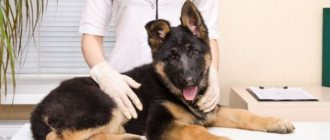- Signs Causes Diagnosis Treatment Home care Prevention
Any decrease in the ability of one or more of a cat's limbs to bear weight, or a change in the normal mobility of a limb, can be called lameness. The lameness can be extremely mild or severe and affect one or more limbs. It can be intermittent or constant, worsening in the morning, at night, after rest, after or during physical activity.
There is no breed or age predisposition to lameness. Lameness may be associated with injury or develop gradually, as with a bone tumor. The underlying cause of lameness may be life-threatening, or may merely reduce quality of life, as with debilitation and painful arthritis.
Why does a cat limp on his front leg: injury
As already mentioned, it is for this reason that a cat begins to limp on its paw most often. If the owners notice that it is difficult for their pet to step on its front paw, they should simply remember if anything has happened recently that could cause the injury. A cat may limp, for example, after an unsuccessful jump. Also, an animal’s paw may begin to hurt after someone steps on it, pinches it in a door, etc. In addition, quite often a similar problem is observed in those cats that are allowed to walk outside. A pet can get injured from other animals, after an unsuccessful jump, etc.
Lameness due to injury can range from mild to severe. In any case, if such a problem is discovered, your pet should be examined first. If the lameness is caused by an injury, a wound or swelling will likely be found on the paw. In this case, the animal owner should just wait a day. Most likely, the cat's injury, if he can still step on his paw, will go away after this time.
If the cat does not stop limping after 24 hours, you should take him to the veterinarian. The doctor will examine the animal, make the correct diagnosis and prescribe treatment.
The reasons why the cat began to limp on its front leg could be:
- cuts and punctures;
- fractures and dislocations;
- splinters.
Also, a cat, for example, can break a claw if it jumps unsuccessfully. In this case, the animal will subsequently experience quite severe pain for a long time and, accordingly, will begin to limp.
Causes
Sudden lameness is most often associated with injury. Injuries can be very different: a splinter in the paw, an insect bite, an unsuccessful jump that caused damage to the wrist ligaments (especially in overweight cats). It may also be associated with spinal diseases. Intervertebral disc extrusion in the neck can cause severe lameness in one of the forelimbs.
Sometimes cats begin limping unexpectedly when the underlying problem has actually already been present for some time, such as with neoplasms.
Arthritis and arthrosis
This problem usually occurs in fairly old animals. In this case, lameness, of course, does not appear suddenly. At first, it becomes only slightly difficult for the pet to step on its foot. Then the problem gets worse.
If a cat has arthritis and is limping on its front leg, what should you do in this case? If there is such a problem, your pet will need to be shown to a specialist. Unfortunately, it is almost impossible to cure arthritis or arthrosis in old animals. The doctor will most likely prescribe only maintenance therapy.
Treatment
Treatment can be as simple as limited mobility for a few days for a minor tendon or ligament sprain, or as complex as orthopedic or neurological surgery.
Sometimes the exact cause of lameness may not be identified. In such cases, a period of limited mobility, possibly with anti-inflammatory treatment, may be recommended to see if the lameness responds to this conservative approach.
Surgery will almost always require postoperative hospitalization and the use of pain medications for a smooth and comfortable recovery. The length of hospital stay and the need for intensive care depend on the severity of the cat's condition, the severity of the problem, and the extent of surgery.
Elbow dysplasia
This disease occurs in both young and old cats. Unfortunately, purebred animals are especially susceptible to it. Cattery owners often use this method of breeding expensive cats as inbreeding. In this case, kittens are born with pronounced breed characteristics. However, inbreeding significantly increases the risk of offspring developing hereditary diseases. One of these ailments is elbow dysplasia.
Signs of this disease can appear in a pet at a very early age. However, lameness in a cat with this problem becomes most noticeable at 2-3 years of age. Of course, such animals should not be allowed to breed. Also, the cat should definitely be taken to the veterinarian.
Like arthrosis, it is unlikely that it will be possible to cure dysplasia in a pet. However, the doctor will still choose a treatment regimen that will make the cat’s life more comfortable. The main symptoms of this disease in cats, in addition to lameness, are:
- crunching sounds when moving;
- X-shaped curvature of the limbs;
- stiffness of movement when standing up.
Back or brain injury and their consequences
The cat has a swollen paw and is limping: what to do?
Unfortunately, more severe injuries resulting from cats falling from a great height (from a balcony, roof) are fraught with bruises, concussion of the brain and spinal cord with subsequent neurological disorders. In addition, they may be accompanied by numerous fractures of the musculoskeletal system.
For your information! A strong blow to the head leads to the destruction of brain cells, and the hypothalamus and brain stem may be damaged. In especially severe cases, cerebral hemorrhages and tissue necrosis occur.
When the spinal cord is contused, a disruption in the functioning of the musculoskeletal system occurs, the animal limps or completely loses the ability to move. Vomiting occurs, the pupils often have different sizes, and they react poorly or not at all to light. The cat begins to spontaneously shake its limbs. The head may fall back, and the pet may lose consciousness or fall into a coma.
Important! The cat's symptoms and behavior depend on how severely the animal is injured. In severe forms with rupture of the spinal cord membranes, the sensitivity of the limbs and tail is completely lost.
If the cat is unconscious or in shock, under no circumstances should you shake it or apply ammonia to its nose. You need to make sure that the tongue is not stuck and take it to the veterinarian in your arms. Only a specialist can assess the degree of concussion. Depending on the situation, he will give the necessary injections of antibiotics and sedatives. In some cases, the use of medications to support heart function will be required. The doctor will give the necessary recommendations for care and treatment. The recovery of a cat is long, up to 4-8 weeks or more (depending on the age of the animal and the severity of the condition).
The presence of serious diseases that cause lameness can only be detected by a veterinarian
Osteomyelitis in cats
If a domestic cat is limping on its front leg, this may also indicate that it has developed this dangerous disease. The disease in this case also manifests itself gradually. Osteomyelitis is a disease associated with bone necrosis, accompanied by a purulent-inflammatory process.
Most often, this unpleasant disease occurs in cats under the age of 2 years. At the same time, pets of the Persian breed are considered the most susceptible to it. Veterinarians explain this by hereditary predisposition. Osteomyelitis is usually treated comprehensively - through surgery, as well as medications.
Prevention of lameness
To prevent the onset of arthritis, it is necessary to provide the animal with proper nutrition. Frequent consumption of junk food can cause calcium deposits in the joints. Therefore, you should choose the right diet for your pet.
To reduce the likelihood of lameness, the animal must be given vitamins and protected from injury. To avoid limb atrophy in sedentary cats, you need to play with them more often.
Lameness can be hereditary. Therefore, when buying an animal, you need to study its pedigree.
Additional Information! Lameness is a fairly common phenomenon, so if nothing else bothers the cat other than it, then most likely there is no reason for concern.
Diseases that cause discomfort during movement are quite rare in young and healthy animals. But in any case, it is better to know in advance what to do if the cat has injured its paw and is limping. Then, when such a problem arises, it will be easier to find a solution.
Lameness due to infection
If the cat begins to limp on its front leg, it may have become infected with calcivirus. This disease of an infectious nature is very easily transmitted from a sick animal to a healthy one. For prevention, many cat owners vaccinate them against this disease. Animals that have not been vaccinated can become ill with calcivirus very easily.
In addition to lameness, signs of this disease may include:
- breathing problems;
- conjunctivitis;
- nasal discharge;
- damage to the paw joints;
- the presence of ulcers on the mucous membranes.
This disease causes inflammation of the anterior joint chambers. This is why the cat is limping on his front leg. What should owners do in this case? If you have calcivirosis, the animal should, of course, be shown to a specialist. Treatment in this case is complex - therapeutic and symptomatic.
Another infection that can cause lameness in a cat is a fungus. In this case, dermatophytes often affect not only the animal’s pads or its skin, but also its claws or joints. Lameness in cats in this case develops due to inflammation.
Diagnostics
Anamnesis collection involves a detailed description of the onset, duration and changes in the manifestations of lameness, treatment, if any. The doctor should evaluate how the cat stands, sits, and walks. Sometimes, especially if the lameness occurs periodically, or the cat is very nervous at the appointment, it can be useful to videotape its movements at home and show it to the doctor.
A general examination will also include a careful orthopedic examination - careful examination and palpation of all extremities, identification of pathologically altered or painful lesions, and determination of joint mobility.
Neurological examination. Not all lameness is due to orthopedic problems. A neurological examination may be recommended if the problem is suspected to be at the level of the brain or spinal cord, nerves or muscles.
Other diagnostic tests may be performed, most often x-rays, joint puncture and examination of joint fluid may also be used; ultrasound; CT; MRI; myelography; biopsy; X-ray with contrast.
Pretense
Sometimes it happens that the animal has no visible injuries, but the cat still limps on its front leg. The reason in this case may simply be the nature of the animal. A pet whose paw is slightly pinched or, for example, stepped on, may be offended. In this case, the cat, even if it does not feel any discomfort in its paw, begins to limping demonstratively only in order to express its indignation to its owners.
If the lameness is simply emotional, there will most likely be no damage to the animal's paw. Moreover, after a couple of hours the cat will get tired of playing, and he will stop limping.
Home care
After surgery, you will need to maintain rest and restrictions for your pet. This can last for at least six weeks (for example, with fractures), and the restriction of mobility will cause protest in the cat. However, exercising too early or too heavily will lead to re-injury and make the problem worse. To limit mobility, a cage, playpen or separate room is used in which the cat does not have the opportunity to jump or climb.
If your cat has an external suture, it should be inspected daily for swelling, redness, or discharge. Stitches or staples should be removed 10 to 14 days after surgery.
Some cats simply cannot tolerate the dressing, despite no complications at the surgical site. Elizabethan collars can be helpful in most cases, but the bandage should be removed if it becomes more of a problem than a help.
In what cases should a cat be taken to the veterinarian?
When is specialist help needed? When the animal exhibits at least one of the following symptoms:
- the cat cannot walk at all or moves with great difficulty;
- when you touch the paw, the pet meows and abruptly pulls it away;
- the cat does not step on its paw, tucking it in when moving.
It is also worth visiting a specialist if the cat’s lameness is accompanied by loss of appetite, high fever, increased fatigue, lethargy or aggression. These are already very alarming symptoms.
Why does this happen?
The cause of a concussion in outdoor cats can be a fall from a height, being hit by a car on the road, an awkward jump from a tree, or being hit by a person.
Domestic cats get it as a result of heavy objects falling on them or hitting a wall if the animal is scared or does not have time to brake in time. A concussion is accompanied by cerebrovascular accident and sometimes hemorrhage. This process results in disruption (temporary or permanent) of normal brain activity and activity.
First of all, you need to call a veterinarian. An experienced doctor will provide immediate assistance to the animal.
The cat is limping on his front leg. What to do in this case, how to provide first aid to your pet?
As already mentioned, a limping animal should be left alone for one day and then taken to a veterinarian. Also, if a bruise is revealed during examination, you can apply cold to the affected area for 1 minute, wait 20 seconds and apply again for 1 minute. This operation should be repeated for 5 minutes.
If the owners suspect that the cat has a fracture, he needs to try to fix the paw. In this case, the animal must be taken to the clinic in an immobilized state. You can also try to provide first aid to a cat if he has a minor wound. In this case, the affected area must be carefully cleaned from dirt with a cloth soaked in soapy water. After this, the wound should be treated with furatsilin solution and the animal should be taken to the veterinarian.
Source: fb.ru
First aid
First of all, if a bruise is detected, the animal should be calmed. Then apply ice or a cold object to the sore spot. If the pet has a fracture, then the paw must be fixed and sent to an animal clinic. Here the doctor will take an x-ray and decide on further treatment.
Cat with broken paws
Important! You should not give your cat medications from your home medicine cabinet. They help humans, but can cause serious harm to animals.
How to recognize a bruise or injury to the forelimb
An injury or bruise is fairly easy to spot. With such ailments, the animal cannot step on a limb. When trying to touch a sore spot, the cat will remove its paw.
Cat with an injured paw
Animals that are constantly in an active state often suffer bruises on their limbs. Main signs of damage:
- the limb at the site of the injury begins to swell;
- hematoma, which manifests itself even through the fur;
- there are no visible wounds on the injured paw;
- the paw is in its natural state;
- joints are movable;
- the injured area is slightly warmer to the touch than other areas of the body;
- the animal constantly licks the injured limb.
Cat with a bruised front paw
A fracture, unlike a bruise, should be taken much more seriously. Its signs are easier to identify, even without medical education:
- unnatural shape of the damaged paw;
- a broken bone can be easily felt;
- swelling forms on the paw.
Additional Information! Bruises and fractures are characterized by a sudden onset of lameness. Such injuries can result from a simple jump on a chair or windowsill.
This is interesting: What are the infectious diseases in cats?
Arthritis (inflammation of the joints)
Most often, cats suffer from two forms of this disease: osteoarthritis and traumatic arthritis.
Traumatic arthritis is a consequence of joint trauma. Perhaps your pet unsuccessfully jumped from a great height or was hit by the wheels of a car. In this case, you will notice that the cat is limping or moving stiffly. In addition, the animal may meow restlessly when walking or stroking an injured joint.
Any jumping (on his knees, window sill or sofa) will cause him great pain. It is necessary to examine a specialist who will prescribe anti-inflammatory drugs and apply a supportive bandage. Your task is to provide your pet with a sedentary lifestyle for several days.
Osteoarthritis occurs when a joint loses mobility. More often, mature animals with excess weight and those who were once injured are susceptible to this disease.
The first signs of osteoarthritis include lameness, which appears immediately after sleep or rest. Over time, the diseased joint increases in size, and lameness becomes permanent.
If you notice these signs in your cat, do not delay visiting the veterinarian. The clinic will conduct the necessary studies and offer a course of treatment. In addition to medications, for osteoarthritis the following are prescribed: diet, physiotherapy, massage and exercises to develop joints. In advanced cases, surgical intervention is possible.
It is very important to carefully observe your pet's behavior. Lameness should not be taken lightly; it is better to show the animal to specialists immediately, without waiting for the disease to develop.
Any decrease in the ability of one or more of a cat's limbs to bear weight, or a change in the normal mobility of a limb, can be called lameness. The lameness can be extremely mild or severe and affect one or more limbs. It can be intermittent or constant, worsening in the morning, at night, after rest, after or during physical activity.
There is no breed or age predisposition to lameness. Lameness may be associated with injury or develop gradually, as with a bone tumor. The underlying cause of lameness may be life-threatening, or may merely reduce quality of life, as with debilitation and painful arthritis.
What should the owner do?
Helping a kitten with a broken front paw.
If you notice that your pet is limping, the first thing to do is to immediately examine the paw . Perhaps the cause will become clear, for example, damage or a foreign body in the limb itself.
If there are no visible injuries, you need to take your cat to the vet. He will conduct a manual examination and, most likely, the pet will have to undergo x-rays. Only after a thorough diagnosis will it become clear why the lameness occurred and how serious the situation is, will a treatment strategy for the cat be proposed.











